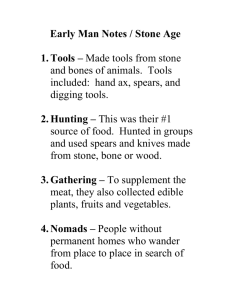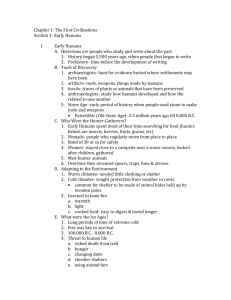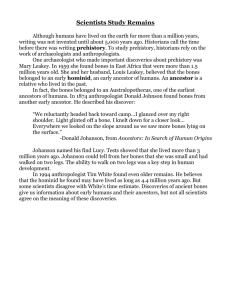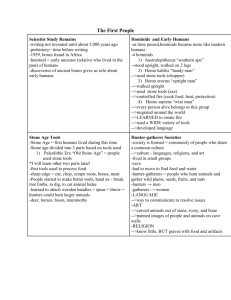Early Human Tools Reading
advertisement
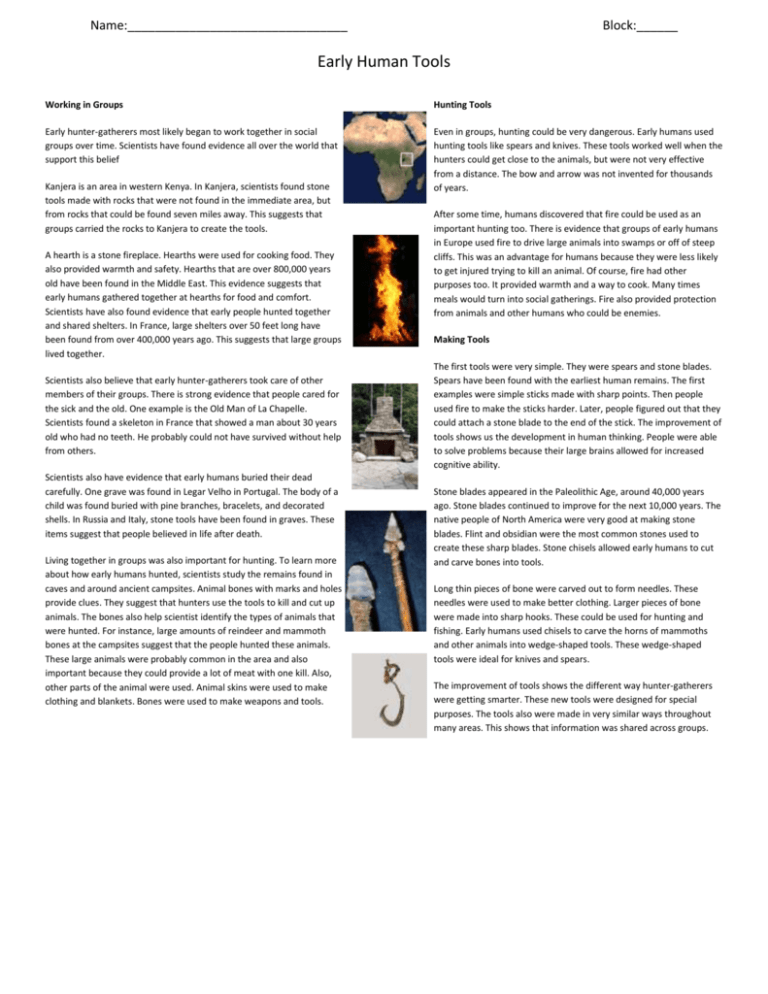
Name:________________________________ Block:______ Early Human Tools Working in Groups Hunting Tools Early hunter-gatherers most likely began to work together in social groups over time. Scientists have found evidence all over the world that support this belief Even in groups, hunting could be very dangerous. Early humans used hunting tools like spears and knives. These tools worked well when the hunters could get close to the animals, but were not very effective from a distance. The bow and arrow was not invented for thousands of years. Kanjera is an area in western Kenya. In Kanjera, scientists found stone tools made with rocks that were not found in the immediate area, but from rocks that could be found seven miles away. This suggests that groups carried the rocks to Kanjera to create the tools. A hearth is a stone fireplace. Hearths were used for cooking food. They also provided warmth and safety. Hearths that are over 800,000 years old have been found in the Middle East. This evidence suggests that early humans gathered together at hearths for food and comfort. Scientists have also found evidence that early people hunted together and shared shelters. In France, large shelters over 50 feet long have been found from over 400,000 years ago. This suggests that large groups lived together. Scientists also believe that early hunter-gatherers took care of other members of their groups. There is strong evidence that people cared for the sick and the old. One example is the Old Man of La Chapelle. Scientists found a skeleton in France that showed a man about 30 years old who had no teeth. He probably could not have survived without help from others. Scientists also have evidence that early humans buried their dead carefully. One grave was found in Legar Velho in Portugal. The body of a child was found buried with pine branches, bracelets, and decorated shells. In Russia and Italy, stone tools have been found in graves. These items suggest that people believed in life after death. Living together in groups was also important for hunting. To learn more about how early humans hunted, scientists study the remains found in caves and around ancient campsites. Animal bones with marks and holes provide clues. They suggest that hunters use the tools to kill and cut up animals. The bones also help scientist identify the types of animals that were hunted. For instance, large amounts of reindeer and mammoth bones at the campsites suggest that the people hunted these animals. These large animals were probably common in the area and also important because they could provide a lot of meat with one kill. Also, other parts of the animal were used. Animal skins were used to make clothing and blankets. Bones were used to make weapons and tools. After some time, humans discovered that fire could be used as an important hunting too. There is evidence that groups of early humans in Europe used fire to drive large animals into swamps or off of steep cliffs. This was an advantage for humans because they were less likely to get injured trying to kill an animal. Of course, fire had other purposes too. It provided warmth and a way to cook. Many times meals would turn into social gatherings. Fire also provided protection from animals and other humans who could be enemies. Making Tools The first tools were very simple. They were spears and stone blades. Spears have been found with the earliest human remains. The first examples were simple sticks made with sharp points. Then people used fire to make the sticks harder. Later, people figured out that they could attach a stone blade to the end of the stick. The improvement of tools shows us the development in human thinking. People were able to solve problems because their large brains allowed for increased cognitive ability. Stone blades appeared in the Paleolithic Age, around 40,000 years ago. Stone blades continued to improve for the next 10,000 years. The native people of North America were very good at making stone blades. Flint and obsidian were the most common stones used to create these sharp blades. Stone chisels allowed early humans to cut and carve bones into tools. Long thin pieces of bone were carved out to form needles. These needles were used to make better clothing. Larger pieces of bone were made into sharp hooks. These could be used for hunting and fishing. Early humans used chisels to carve the horns of mammoths and other animals into wedge-shaped tools. These wedge-shaped tools were ideal for knives and spears. The improvement of tools shows the different way hunter-gatherers were getting smarter. These new tools were designed for special purposes. The tools also were made in very similar ways throughout many areas. This shows that information was shared across groups.
